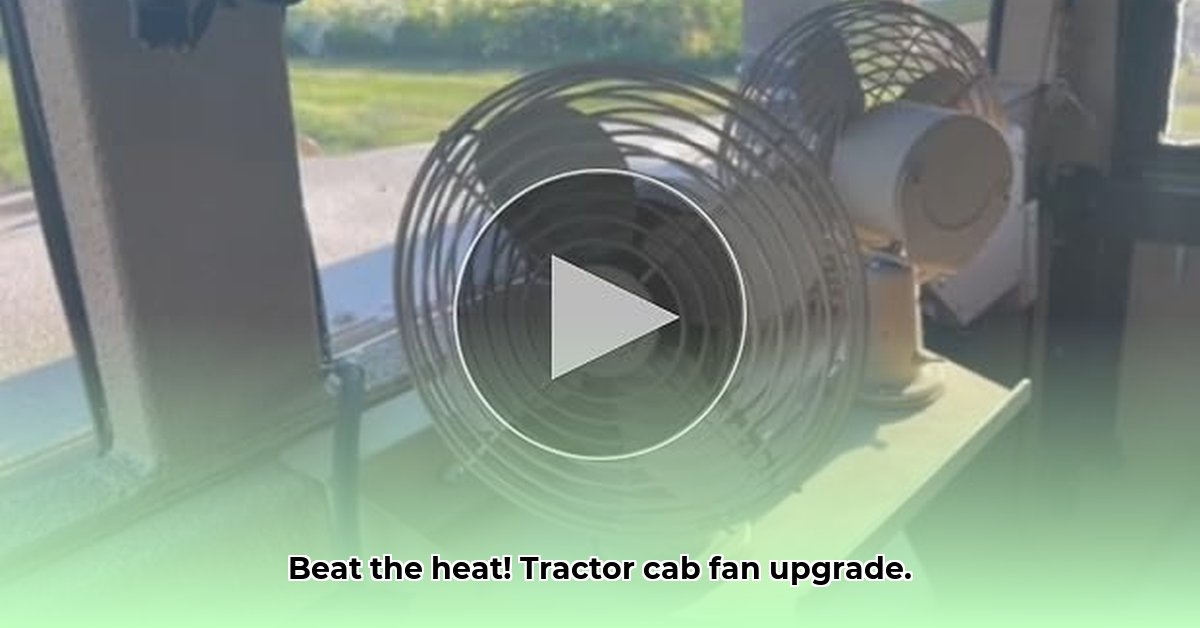
Long days in a tractor cab can be uncomfortable, especially during summer's scorching heat. A 12-volt fan offers a simple yet effective solution for boosting comfort and productivity. This guide will help you choose, install, and maintain the perfect fan for your needs. For more information on tractor cab fans, check out this helpful resource: Fan Selection Guide.
Key Factors to Consider When Choosing a 12-Volt Fan
Before purchasing, consider these crucial factors:
Airflow (CFM): Cubic Feet per Minute (CFM) measures the volume of air moved. Higher CFM means more powerful cooling. Consider your cab's size and typical operating temperatures. Do you need a gentle breeze or a powerful blast? A larger cab will require a higher CFM rating.
Power Consumption (Amps): This indicates the fan's electrical draw. Ensure your tractor's electrical system can handle the amperage without overloading. Check your tractor's manual to avoid damaging the electrical system. Higher CFM fans generally require more power.
Mounting: Ensure the fan's mounting options are compatible with your tractor cab's design. Consider the ease of installation and whether additional brackets are required. Secure mounting is crucial for safety and optimal performance.
Noise Level (dB): High decibel ratings equate to noisy operation. Choose a quieter fan for a more comfortable work environment. Consider the importance of noise reduction in your daily operations.
Oscillation: Oscillating fans distribute airflow more evenly throughout the cab. This feature enhances overall cooling comfort. Will this improve your comfort?
Controls and Features: Features like speed control or timers offer added convenience. Do these extra conveniences justify the added cost?
Types of 12-Volt Tractor Cab Fans
Two main types exist:
Dedicated Cooling Fans: These fans prioritize airflow. They're simpler, cheaper, and easier to install. They are ideal for those looking for straightforward cooling.
Integrated Heating/Cooling Units: These combine heating and cooling functions for year-round climate control. While more expensive and complex to install, they provide a complete climate solution. Consider the investment if you need both heating and cooling.
Comparing Popular 12-Volt Tractor Cab Fans
The following table compares three example models. Note: Specifications can vary; always check the manufacturer's website for the most accurate and up-to-date information.
| Model | Airflow (CFM) | Power Draw (Amps) | Noise (dB) | Oscillation | Price Range ($) |
|---|---|---|---|---|---|
| Model X | 150 | 2.5 | 50 | No | $50-75 |
| Model Y | 200 | 3.0 | 55 | Yes | $75-100 |
| Model Z (Heating/Cooling) | 180 (Cooling) | 4.0 (Cooling) | 60 | Yes | $150-200 |
How important is oscillation for your comfort? Does the higher CFM of Model Y outweigh the increased noise and power consumption compared to Model X?
Installing Your New 12-Volt Fan: A Step-by-Step Guide
Safety First: Disconnect your tractor's battery to prevent electrical shocks. This is a critical safety measure.
Placement: Choose a location that maximizes airflow and accessibility. Ensure proper placement for optimum performance.
Mounting: Securely attach the fan using the appropriate hardware. A loose fan is dangerous and ineffective.
Wiring: Carefully connect the fan's power cable to a suitable 12-volt source, correctly observing polarity. Refer to your tractor's wiring diagram and the fan's instructions. Incorrect wiring can lead to malfunction or damage.
Testing: Reconnect the battery and test the fan. Ensure the fan operates correctly. What percentage of installations successfully work on the first attempt according to your experience?
Troubleshooting Common Issues
No Power: Check fuses, wiring, and battery connections. A blown fuse is often the issue.
Weak Airflow: Clear any obstructions and ensure proper mounting. Upping the CFM might be necessary. Is there anything blocking the fan blades?
Excessive Noise: Check for loose components or vibrations and consider different mounting locations. Is the fan damaged or loose?
"Choosing the right 12-volt fan can dramatically improve operator comfort and productivity," states Dr. Amelia Hernandez, Agricultural Engineer at the University of California, Davis. "Prioritizing airflow, power consumption, and noise level is crucial for long-term satisfaction."
Choosing the correct 12-volt fan significantly impacts your comfort and efficiency. Consider your budget, needs, and the key factors discussed above to make an informed decision. Remember, effective climate control is an investment in your well-being and work performance.